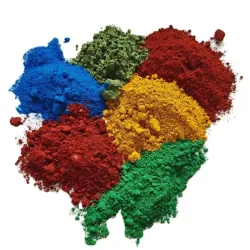Features and characteristics of ultramarine blue pigment
2024-04-07
Ultramarine blue is a deep blue pigment that has been used for centuries in art, textiles, and various other applications. Here are some key features and characteristics of ultramarine blue pigment:
1. Origin:
- Ultramarine blue pigment has been historically derived from the semi-precious gemstone lapis lazuli, which was ground into a powder and processed to create the pigment.
- The name "ultramarine" originates from the Latin word "ultramarinus," meaning "beyond the sea," reflecting the distant origins of the pigment from regions such as Afghanistan and Persia.
2. Color and Appearance:
- Ultramarine blue pigment is prized for its deep, rich blue color with a subtle violet undertone, often described as "French ultramarine" or "genuine ultramarine."
- It has a characteristic brightness and intensity that makes it a popular choice for artists seeking vibrant blues in their paintings.
- Ultramarine blue pigment is transparent, allowing it to be used for glazing techniques to create layered effects in artworks.
3. Lightfastness:
- Ultramarine blue pigment is known for its excellent lightfastness, meaning that it retains its color and does not fade significantly when exposed to light over time.
- This property makes ultramarine blue a preferred choice for artists who require pigments with long-term durability and color stability in their artworks.
4. Versatility:
- Ultramarine blue pigment is used in a wide range of applications, including oil and acrylic painting, watercolor painting, pastel drawing, and printmaking.
- It can be used alone or mixed with other pigments to create various shades of blue and violet, as well as to modify the characteristics of other colors.
5. Synthetic Ultramarine:
- In the 19th century, a synthetic version of ultramarine blue pigment was developed as an alternative to the natural pigment derived from lapis lazuli.
- Synthetic ultramarine pigments are produced through chemical processes using ingredients such as kaolin, sulfur, soda ash, and silica.
- Synthetic ultramarine pigments are more affordable and readily available than natural ultramarine pigments, making them the preferred choice for many artists and industrial applications.
6. Applications:
- Ultramarine blue pigment is used in a wide range of applications beyond fine art, including textiles, ceramics, plastics, cosmetics, and coatings.
- In textiles, ultramarine blue pigment is used to dye fabrics and yarns, imparting a rich blue color to clothing, upholstery, and other textile products.
- In cosmetics, ultramarine blue pigment is used in products such as eye shadows, nail polishes, and lipsticks to provide intense blue coloration.
Overall, ultramarine blue pigment is valued for its deep blue color, lightfastness, and versatility in various artistic and industrial applications. Whether derived from natural lapis lazuli or produced synthetically, ultramarine blue continues to be a popular choice for artists and manufacturers seeking vibrant and durable blue pigments.



